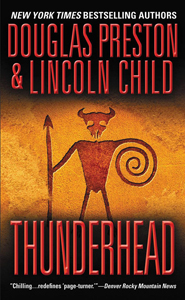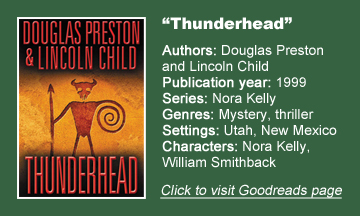Archaeologist Nora Kelly enters the pantheon of Douglas Preston and Lincoln Child’s heroes in “Thunderhead” (1999), an early and still great example of their Southwestern mystery adventures. In 2019, she’d still be going strong in “Old Bones,” the first of a series marketed with Nora as the lead character. I picture her in my head like “Lost World: Jurassic Park”-era Julianne Moore.
Nora takes the lead
Nora bumps Margo Green aside as P&C’s favorite female lead. Although there are similarities, Green starts off mousy and is forced to develop a tougher edge through the museum and New York underground terrors, whereas Kelly has an edge to begin with.
She’s the daughter of an archaeologist who whose dying letter to his wife (since deceased) shows up in the mailbox of the now-decrepit Kelly family ranch in New Mexico 16 years later.
“Thunderhead” finds Nora coming into her own as a leader. Interestingly, her biggest challenge comes from another woman: Sloane Goddard, the daughter of the Santa Fe Institute leader who commissions this outing into remote canyons of Utah.
Everyone else on the expedition is a man, including New York Times journalist Bill Smithback, whose “incorrigible” attitude eventually grows on Nora.
P&C get more comfortable writing a relationship thread here, but “Thunderhead” remains squarely in their comfort zone of darkly engaging adventure/mystery. The authors start from a good place as the mission is to find a legendary Anasazi cliff city.
They tap into a lot of theories about the Native American tribe that left large alcove dwellings behind, including the notion that they may have been taken over and ruled by Aztecs, who may have brought cannibalism and/or human sacrifice into the culture.
Geography lesson
This might be my shortcoming as a reader, since I notice it on a lot of books, but I find the geographic details hard to follow because I don’t immediately grasp all the terms, for example the distinction between “canyon” and “valley.” In the city itself, “roomblocks” come into play; is that another word for “room”? And each of the three stories have “roofs” and yet they are stacked atop each other.
“Thunderhead” helps out with two maps, positioned in the book so as not to deliver spoilers before the reader gets there. I should check out Preston’s nonfiction “Talking to the Ground” to get a better feel for terminology.
That said, “Thunderhead’s” description of a flash flood is incredible. Not merely a wall of water, it includes debris at the front edge, and it’s so powerful that the air pressure changes at the leading edge.
Although the authors make up some of the geographical specifics, Utah’s Lake Powell is one real thing that had me going to Google. It’s a man-made lake that, according to “Thunderhead,” left many archeological treasures underwater before they could even be documented. P&C would later explore the history and geography of a man-made lake in more detail with California’s Salton Sea in “Blue Labyrinth.”

We also get a sneak-preview of LIDAR-based archeological discovery here, although they aren’t using LIDAR just yet – that tech would be up and running by the time of Preston’s real-world Central American account “The Lost City of the Monkey God” (2017).
In “Thunderhead,” technician Holroyd uses his computer skills to get radar data to spill its secrets of where an old Anasazi road is located by reading the location of charcoal.
Flirting with the supernatural
As also seen in the “Relic” books, P&C have a knack for introducing near-supernatural ideas and then hitting us with real science that sounds valid enough that it ties together. Key elements of their books could be explained as supernatural, yet they are in the ballpark of reality, thus making them scarier.
Instead of a Museum Beast or Wrinklers, here we get skinwalkers, whose presence is announced not with a goatish odor but instead with the smell of morning glories. That’s refreshing, perhaps, but you’ll be equally dead.
Scarier still, especially in the coronavirus age, is corpse powder, which is made with a method involving human corpses and functions as a deadly airborne poison.
The Anasazi mysteries and the spookiness of the skinwalkers and poison keep a reader turning the pages of “Thunderhead.” But by the end, we’ve absorbed geographical and historical knowledge in this early example of P&C illustrating that some parts of the Earth remain removed from civilization and full of secrets.


